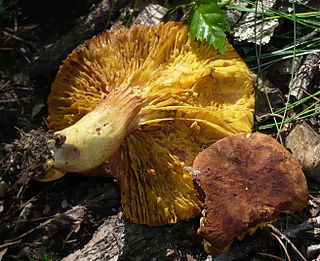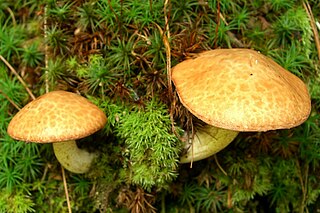
The Boletaceae are a family of mushroom-forming fungi, primarily characterised by small pores on the spore-bearing hymenial surface, instead of gills as are found in most agarics. Nearly as widely distributed as the agarics, the family is renowned for hosting some prime edible species highly sought after by mushroom hunters worldwide, such as the cep or king bolete . A number of rare or threatened species are also present in the family, that have become the focus of increasing conservation concerns. As a whole, the typical members of the family are commonly known as boletes.

Xerocomus is a genus of poroid fungi related to Boletus. Many mycologists did not originally recognize the distinction between the two genera and placed Xerocomus taxa in genus Boletus. However, several molecular phylogenetic studies have demonstrated that Xerocomus is a heterogeneous genus of polyphyletic origin, which has resulted in further division of Xerocomus into Xerocomellus and Hemileccinum. The members of the genus Xerocomellus are more closely related to Boletus than true Xerocomus is, which is relatively distantly related to Boletus and more closely related to Phylloporus. Other former Xerocomus species have since been moved to Aureoboletus, Imleria, Hortiboletus and Rheubarbariboletus.

Phylloporus is a genus of fungi in the family Boletaceae. The genus has a cosmopolitan distribution, and contains about 50 species, mostly in tropical areas.

Bothia is a fungal genus in the family Boletaceae. A monotypic genus, it contains the single species Bothia castanella, a bolete mushroom first described scientifically in 1900 from collections made in New Jersey. Found in the eastern United States, Costa Rica, China, and Taiwan, it grows in a mycorrhizal association with oak trees. Its fruit body is chestnut brown, the cap is smooth and dry, and the underside of the cap has radially elongated tubes. The spore deposit is yellow-brown. The edibility of the mushroom is unknown. Historically, its unique combination of morphological features resulted in the transfer of B. castanella to six different Boletaceae genera. Molecular phylogenetic analysis, published in 2007, demonstrated that the species was genetically unique enough to warrant placement in its own genus.

Phylloporus rhodoxanthus, commonly known as the gilled bolete, is a species of fungus in the family Boletaceae. As suggested by its common name, the distinctive feature of this species is its yellow gills—an unusual feature on a bolete mushroom.
Phylloporus veluticeps is a species of fungus in the family Boletaceae.

Phylloporus pelletieri, commonly known as the golden-gilled bolete, is a species of fungus in the family Boletaceae.
Psiloboletinus is a fungal genus in the family Suillaceae. This is a monotypic genus, containing the single species Psiloboletinus lariceti, first described by mycologist Rolf Singer in 1938 as a species of Phylloporus. Alexander H. Smith disagreed with Singer's generic concept, concluding "No matter what disposition of the type species of Psiloboletinus is eventually made, it is evident that there are no clearly distinctive characters on which to recognize the genus on the basis of Singer's descriptions."
Phylloporus alborufus is a species of fungus in the family Boletaceae. It was first described as a new species in 2010.
Phylloporus scabripes is a species of bolete fungus in the family Boletaceae. Found in Belize on sandy soil under Quercus spp. and Pinus caribaea, it was described as new to science in 2007.

Boletus abruptibulbus is a species of bolete mushroom in the family Boletaceae. Described as new to science in 2009, it is found only in the Gulf Coast of the Florida Panhandle, where it grows on the ground in coastal sand dunes, one of only three North American boletes known to favor this habitat. The fruit bodies have convex brownish caps up to 8 cm (3.1 in) in diameter, supported by solid yellowish to reddish stems measuring 3–5 cm (1.2–2.0 in) long by 10–15 mm (0.4–0.6 in) thick. The pores on the underside of the cap measure about 1–2 mm in diameter and are initially pale yellow before developing a greenish tinge in age. The mushroom's spores, about 20 micrometers long, are unusually long for a member of the Boletaceae. The stem base is bulbous, a diagnostic feature for which the species is named.

Leccinum arenicola is a species of bolete mushroom in the family Boletaceae. Described in 1979, the fruit bodies (mushrooms) grow in sand dunes from New Brunswick south to Cape Cod.

Phylloporus arenicola is a species of bolete mushroom in the family Boletaceae. It is found in the Pacific Northwest region of western North America, where it grows in sand dunes in a mycorrhizal association with pine trees. It is one of only three North American Boletaceae species that occur in coastal sand dunes.

Phylloporus leucomycelinus is a species of bolete fungus in the family Boletaceae. First described in 1978, it is found in eastern North America and the Philippines.

Suillus subaureus is a rare species of bolete fungus in the family Suillaceae. It is found in North America, where it associates with deciduous trees. Originally described in 1887 by Charles Horton Peck, it was transferred to genus Suillus by Wally Snell in 1944. Fruitbodies are pale yellow—reflecting its specific epithet subaureus, which means "somewhat golden yellow". The spore print is olive brown. Spores are smooth and inamyloid, and measure 7–10 by 2.7–3.5 µm. It has also been recorded in Taiwan.

Rheubarbariboletus is a fungal genus in the family Boletaceae. Circumscribed in 2014, it contains two species found in Europe: Rheubarbariboletus persicolor, and the type, R. armeniacus. The generic name is derived from the Latin rheubarbarum, meaning "rhubarb", referring to the color of the flesh at the base of the stipe. The genus is closely related to Xerocomellus, but differs by having smooth spores, the unchanging yellowish to orange-rhubarb coloring of the stipe base, and the distinctive dark-green to black color reaction with iron sulphate on both the surface of the cap and on the flesh of the stipe.
Phylloporus attenuatus is a species of the fungal family Boletaceae. It was first described as a new species in 2017 from Bangladesh. This fungus is putatively associated with Shorea robusta.
Phylloporus catenulatus is a species of the fungal family Boletaceae. It was first described as a new species in 2017 from Bangladesh. This fungus is putatively associated with Shorea robusta.
Kaziboletus is a fungal genus in the family Boletaceae. Newly described in 2021, it is monotypic, containing the single species Kaziboletus rufescens, found in Bangladesh. The generic name Kaziboletus honors Kazi M. Badruddoza, a national emeritus scientist and founder of modern agriculture of Bangladesh, while rufescens refers to the context, which changes from white to pale red or reddish orange in patches when exposed.
Tylopilus glutinosus is a species of the fungal family Boletaceae. It is the first generic report for Bangladesh. This species is putatively associated with Shorea robusta.










